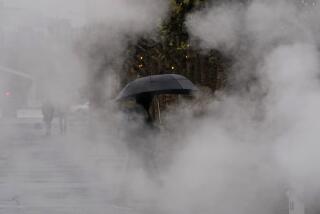Agreement Near on Sewer Plant Capacity
THOUSAND OAKS — City Council members came closer to resolving their seemingly endless sewer fight Friday with the release of the latest consultants’ report on the city’s future sanitation needs.
The report on expansion plans for the Hill Canyon Wastewater Treatment Plant--the source of two years of council skirmishing--says the facility should be expanded from its current capacity of 10 million gallons a day to 14.4 million.
The city’s Public Works Department had recommended that the plan be upgraded to handle 14 million gallons.
Slow-growth council members Linda Parks and Elois Zeanah, who had staunchly maintained that Thousand Oaks could do with a much smaller expansion--perhaps only to 12 million gallons--said they supported the new study’s findings.
“I agree with the report,” said Parks, who has argued that enlarging the sewer plant would invite more development.
“The big picture is, they both come back 14 million gallons. I think we can move forward,” she said.
Added Zeanah: “I will accept the report . . . Now it’s just a matter of getting the funding settled.”
The $25,000 report was prepared by three consultants selected in April to pore over city data and review earlier consultants’ reports. It settles only one issue in a debate that has spanned numerous public meetings, which often stretch long into the night.
All council members agree that the aging Hill Canyon plant, built in the 1960s, needs to be upgraded and expanded. But just how big the plant should be and who should pay for it has been among the most divisive issues in Thousand Oaks politics.
The plant now operates at about 83% of its current 10-million-gallon capacity, and state law requires that the city take action to make sure that the capacity is not exceeded.
Plans drawn up by city staff members for increasing capacity to 14 million gallons are part of a proposed $75-million upgrade.
City officials have suggested a sewer fee increase to pay for about 30% of the upgrade, which is expected to take 15 years; developers would pay for the remainder.
But Parks and Zeanah have argued that a larger sewer plant would open the floodgates to further development. They have opposed a sewer fee increase for existing residents to fund the upgrade, and said that the $75-million plan is much more expensive than necessary.
During a nine-hour debate earlier this year, council members agreed to hire consultants to study the city’s data on sewage flows.
Councilman Mike Markey argued that the new study backs up the city’s initial projections.
“We’ve had a lot of looks at this,” Markey said. “We’ve consulted this to death. These experts know how to calculate, and it shows, for our population, this is what we need to build. Building less would be a deficiency for this community.”
But Markey said he anticipated continued resistance from Parks and Zeanah on the price of the upgrade and how much current residents should have to pay.
“What’s gonna happen is, they’re going to say, ‘We still have a problem with the cost,’ ” Markey added. “They’re flip-flopping. The issue is, they don’t want a waste-water plant, period. They don’t want to control growth. They want to stop it.”
Council members still have issues to resolve, according to Zeanah.
“Now we should look at rate increases and the total cost of the plant,” she said.
More to Read
Sign up for Essential California
The most important California stories and recommendations in your inbox every morning.
You may occasionally receive promotional content from the Los Angeles Times.









